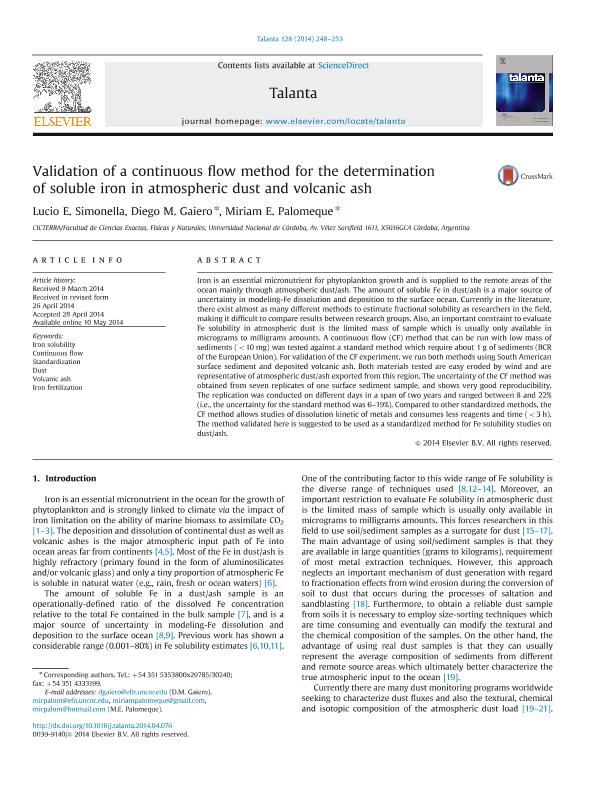Mostrar el registro sencillo del ítem
dc.contributor.author
Simonella, Lucio Esteban

dc.contributor.author
Gaiero, Diego Marcelo

dc.contributor.author
Palomeque, Miriam Edid

dc.date.available
2017-12-26T19:03:17Z
dc.date.issued
2014-04
dc.identifier.citation
Palomeque, Miriam Edid; Gaiero, Diego Marcelo; Simonella, Lucio Esteban; Validation of a continuous flow method for the determination of soluble iron in atmospheric dust and volcanic ash; Elsevier Science; Talanta; 128; 4-2014; 248-253
dc.identifier.issn
0039-9140
dc.identifier.uri
http://hdl.handle.net/11336/31574
dc.description.abstract
Iron is an essential micronutrient for phytoplankton growth and is supplied to the remote areas of the ocean mainly through atmospheric dust/ash. The amount of soluble Fe in dust/ash is a major source of uncertainty in modeling-Fe dissolution and deposition to the surface ocean. Currently in the literature, there exist almost as many different methods to estimate fractional solubility as researchers in the field, making it difficult to compare results between research groups. Also, an important constraint to evaluate Fe solubility in atmospheric dust is the limited mass of sample which is usually only available in micrograms to milligrams amounts. A continuous flow (CF) method that can be run with low mass of sediments (<10 mg) was tested against a standard method which require about 1 g of sediments (BCR of the European Union). For validation of the CF experiment, we run both methods using South American surface sediment and deposited volcanic ash. Both materials tested are easy eroded by wind and are representative of atmospheric dust/ash exported from this region. The uncertainty of the CF method was obtained from seven replicates of one surface sediment sample, and shows very good reproducibility. The replication was conducted on different days in a span of two years and ranged between 8 and 22% (i.e., the uncertainty for the standard method was 6–19%). Compared to other standardized methods, the CF method allows studies of dissolution kinetic of metals and consumes less reagents and time (<3 h). The method validated here is suggested to be used as a standardized method for Fe solubility studies on dust/ash.
dc.format
application/pdf
dc.language.iso
eng
dc.publisher
Elsevier Science

dc.rights
info:eu-repo/semantics/openAccess
dc.rights.uri
https://creativecommons.org/licenses/by-nc-sa/2.5/ar/
dc.subject
Iron Solubility
dc.subject
Dust
dc.subject
Volcanic Ash
dc.subject
Iron Fertilization
dc.subject
Continuous flow
dc.subject
Standardization
dc.subject.classification
Meteorología y Ciencias Atmosféricas

dc.subject.classification
Ciencias de la Tierra y relacionadas con el Medio Ambiente

dc.subject.classification
CIENCIAS NATURALES Y EXACTAS

dc.title
Validation of a continuous flow method for the determination of soluble iron in atmospheric dust and volcanic ash
dc.type
info:eu-repo/semantics/article
dc.type
info:ar-repo/semantics/artículo
dc.type
info:eu-repo/semantics/publishedVersion
dc.date.updated
2017-12-26T14:31:30Z
dc.journal.volume
128
dc.journal.pagination
248-253
dc.journal.pais
Países Bajos

dc.journal.ciudad
Amsterdam
dc.description.fil
Fil: Simonella, Lucio Esteban. Consejo Nacional de Investigaciones Científicas y Técnicas. Centro Científico Tecnológico Conicet - Córdoba. Centro de Investigaciones en Ciencias de la Tierra. Universidad Nacional de Córdoba. Facultad de Ciencias Exactas Físicas y Naturales. Centro de Investigaciones en Ciencias de la Tierra; Argentina
dc.description.fil
Fil: Gaiero, Diego Marcelo. Consejo Nacional de Investigaciones Científicas y Técnicas. Centro Científico Tecnológico Conicet - Córdoba. Centro de Investigaciones en Ciencias de la Tierra. Universidad Nacional de Córdoba. Facultad de Ciencias Exactas Físicas y Naturales. Centro de Investigaciones en Ciencias de la Tierra; Argentina
dc.description.fil
Fil: Palomeque, Miriam Edid. Consejo Nacional de Investigaciones Científicas y Técnicas. Centro Científico Tecnológico Conicet - Córdoba. Centro de Investigaciones en Ciencias de la Tierra. Universidad Nacional de Córdoba. Facultad de Ciencias Exactas Físicas y Naturales. Centro de Investigaciones en Ciencias de la Tierra; Argentina
dc.journal.title
Talanta

dc.relation.alternativeid
info:eu-repo/semantics/altIdentifier/doi/http://dx.doi.org/10.1016/j.talanta.2014.04.076
dc.relation.alternativeid
info:eu-repo/semantics/altIdentifier/url/http://www.sciencedirect.com/science/article/pii/S0039914014003543
Archivos asociados
